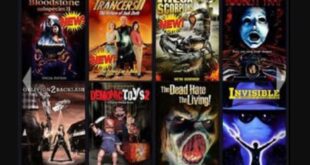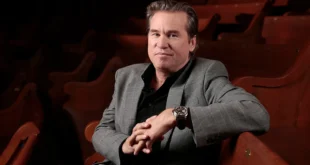Universal Studios gave birth to some of the greatest films of all time, from Jaws (1975 – read one of our writer’s thoughts on the film here) to Jurassic Park (1993). There is no denying their legacy and power in the film industry. However, Universal’s bread and butter has always been horror movies.
Some say Universal’s horror movies started in the 1920s, which holds some truth. In 1923, Universal released The Hunchback of Notre Dame starring Lon Chaney, Sr. (London After Midnight). Two years later, their definitive version of The Phantom of the Opera came out, and again starring Chaney.
The studio was just testing the waters in the ’20s, bringing German Expressionism over to the western world. Things would change in the 1930s. Universal would begin to create horror films that stood the test of time, movies that changed the genre forever. In the ’30s, Universal gave us the real monsters.
Dracula (1931)

The first official Monster movie Universal would make was Dracula, which came out on February 14, 1931, when they introduced the world to the fiendish vampire, Dracula, played by Bela Lugosi (Bride of the Monster), who also portrayed the vampire during a stage production a few years prior to the film, helping bring the fiendish creature to mainstream success. The film also stars Dwight Frye (Frankenstein), Helen Chandler (Daybreak), and Edward Van Sloan (Dracula’s Daughter) as Van Helsing.
Universal selected Tod Browning (Freaks) to direct the picture. The film’s budget was just $355,000, and 48 hours after its initial release at New York’s Roxy Theatre, 50,000 tickets had been sold, earned the Box Office them $700,000. Dracula was praised by critics, making it one of Universal’s most successful films ever.
Even after almost 90 years since its release, Dracula still holds up today. Lugosi’s performance gives the audience a false sense of security. Dracula makes himself out to be a gentle being; however, his true intentions slowly reveal themselves as the film goes on.
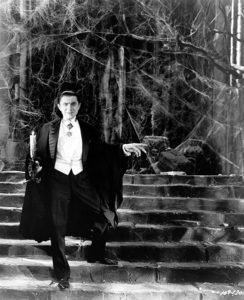
The camera work is incredible, and the Gothic feeling is true to form. Most early Universal films have that German influence with the deep shadows and low light shots, as does this one.
As good a film as Dracula is, it is not my go to for Universal’s classic Monsters. That doesn’t mean I don’t enjoy it. I watch it when I want time to slow down and focus on something else. The movie is slow and foreboding, perfect for a stormy night. It’s the perfect film to watch when your mind is everywhere.
My Rating: A
Frankenstein (1931)
After the success of Dracula, Universal turned to Mary Shelley’s classic tale of life and death. Released on November 21, 1931, Frankenstein took its audience on an entirely different ride.

Directed by James Whale (The Mummy) and starring Boris Karloff (The Raven), Frankenstein was a success from the start. However, the film did meet some controversy. For starters, when Dr. Frankenstein, played by Colin Clive (The Key) shouts his famous, “It’s alive!” line, he followed it up with, “By the name of God, now I know what it feels like to be God!” As you can already assume, this angered Christians.
The other bit of controversy came later on in the film when the Monster throws the little girl in the lake. The scene was so bad that not even Karloff wanted to do it. The worst part of the situation, though, was watching the girl’s father carry her lifeless body through town. Both the “God” line and the little girl’s murder were cut from re-releases.
Even years after Frankenstein’s release, it was still a box office success. With a budget of $262,007, the film’s overall revenue was up to $12 million thanks to subsequent re-releases, making it Universal’s most successful film at the time.
I think Frankenstein is the greatest horror movie of all time. It’s perfect—from Karloff’s deliberate acting as the Monster to Dr. Frankenstein’s descent into madness as he slowly realizes he made a mistake. Edward Van Sloan makes another appearance in this film playing Frankenstein’s mentor.
The Monster’s famous look was done by none other than legendary makeup artist Jack Pierce. Karloff would show up to the studio early in the morning, it would take hours for Pierce to apply the effects. Pierce and Karloff became very good friends after filming and would later collaborate on several other projects.
Production Notes

Early on while Frankenstein was in production, pictures of Karloff and Pierce were released with a towel over the Monster’s head. They wanted to keep the makeup a secret until the movie was finally unleashed upon the world.
This is the film that made me love the Universal Monsters. It also made Boris Karloff my favorite actor of all time. Frankenstein is exactly what horror should be … scary and unnerving. The lack of music makes it even more intense. The opening to the film had a warning due to how disturbing it was. Audiences weren’t ready for this movie, yet Universal released it anyway.
My Rating: A+
The Mummy (1932)
A year after the success of Dracula and Frankenstein, Universal’s Monsters returned to movies theaters across America. The Mummy was freed from his tomb on December 22, 1932. Boris Karloff plays Imhotep, a highly knowledgeable and dangerous priest of ancient Egypt. Imhotep is hell-bent on resurrecting is past lover by stealing the Scroll of Thoth. Karloff is offered his first speaking roll, and he does a wonderful job at chilling the audience with his monotone voice.

The Mummy’s budget was around $196,000, and although it was popular in the United States, the film thrived in the UK. The movie was directed by Karl Freund (Mad Love), the cinematographer for Metropolis (1927) and Dracula (1931).

The Mummy also starred regulars like Edward Van Sloan, but had new faces as well, like Zita Johann (Tiger Shark) as Imhotep’s love.
What The Mummy does right is keep the audience guessing. Imhotep is so calm, yet he’s so terrifying; you never know what he’s going to do next. The lighting in the film is amazing and helps to show how dark the creature’s motives truly are.
Jack Pierce returned to do the makeup on The Mummy. After creating one of the most famous Monsters ever in Frankenstein, Pierce did it yet again in this film. Imhotep’s pre-human form, when he’s wrapped in bandages, is incredibly creepy. However, he’s just as scary in his human form, with his blank, lifeless eyes.
To me, this movie is amazing, one of the best in the Universal Monsters series. The Mummy moves slower than Frankenstein. However, I feel that’s what makes it better in some ways. The deliberate acting added with Universal’s signature deep shadows makes this film a classic.
My Rating: A
The Invisible Man (1933)
Another year goes by without a Monster movie. However, it was worth the wait. This time, Universal took their inspiration from H.G. Wells’ classic, The Invisible Man, a film that was revolutionary in the special effects department and yet another success for Universal. Released on November 13, 1933, the film’s budget was $328,033.

The picture starred a newcomer to Universal, Claude Rains (Casablanca), who played the mad scientist, Dr. Jack Griffith, and was directed by Frankenstein’s James Whale. In the movie, Griffith has just turned himself invisible in a science experiment, and for the first 20 minutes, he is trying to reverse the results. However, he starts to feel power hungry, hoping his invisibility will help him rule the world.
The movie is primarily known for its groundbreaking special effects which were conceived by John P. Fulton and Frank D. Williams. When Griffith had no clothes on, the effects were done with wires. However, when he had clothes on, the filmmakers put Rains in a black velvet suit while standing in front of a black velvet background. The shot was then merged with another shot of the location where the scene was supposed to have taken place. Afterwords, the filmmakers used a matte process to finish off the effect.
The Invisible Man was Universal’s most successful film since Frankenstein, although H.G. Wells wasn’t very happy with it. At a dinner to honor the release, he said, “… [the picture] had taken his brilliant scientist and changed him into a lunatic, a liberty he could not condone.” He felt this film was an attack to his novel.
Regardless of Wells’ opinion, audiences loved it. It was the first Universal movie to steer away from the dark shadows it once knew. It also had some comedy in it. Rains’ performance was superb and made you feel bad for Griffith, even though he was crazy.

The Invisible Man is easily in my top three favorite Universal Monster movies. It’s unique and incredibly re-watchable. It’s dark but not in the way Universal is known for. Instead of a Monster, you have a man who made a scientific mistake and turned himself into a Monster.
My Rating: A+
The Bride Of Frankenstein (1935)
The first of many sequels Universal would produce was just as popular as the original. Directed by James Whale and starring the same familiar faces, The Bride Of Frankenstein was royalty. The undead were married on April 20, 1935. Elsa Lanchester (Witness For The Prosecution) played the newly revived bride of Frankenstein’s wicked creation. Lanchester did an amazing job, although she didn’t have much screen time. And Karloff was fabulous always.

However, something about this movie was different. This is first film where the Monster actually spoke. Karloff said only a few lines, but they were so meaningful, they made you pity the Monster. All he wanted was a friend.
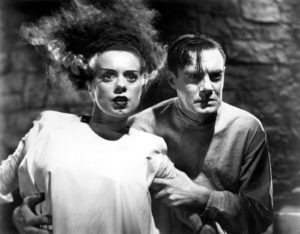
The movie grossed $2 million at the box office, with a budget of $397,000. The Bride of Frankenstein was another smash hit for Universal.
Although I do enjoy the film, I feel it’s not as re-watchable as its predecessor. The original had a magic to that I think was lacking in the sequel a bit. However, the film has one of my favorite endings ever that really ties it all together. The Monster killing himself along with the bride, allowing his creator to live—almost as forgiveness—was incredible.
My Rating: A-
Werewolf of London (1935)
Werewolf Of London was the first werewolf movie Universal would release and a fantastic one at that. Directed by Stuart Walker (Mystery Of Edwin Drood), the movie was released on May 13, 1935. It was then that the world was introduced to renowned biologist Henry Hull who played Wilfred Glendon (The Revelers).
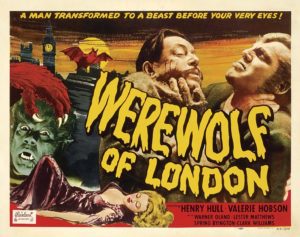
Glendon was attacked by a wolf in Tibet after discovering a new flower. He goes back to London to study his findings, but turns into a werewolf himself. He also finds out that the plant he discovered is a temporary cure for the curse.
Werewolf Of London is brilliant and has some of the best makeup effects out of all 30 films. Hull’s performance is terrifying, putting him right up their with Karloff and Lugosi. The movie’s budget was just a mere $195,000, but they made it work so well.
Something else to notice about this movie is in Glendon’s lab; he has a camera setup at his front door that is wired to a screen in his laboratory. Pretty high tech stuff, considering the era when the film was made.

I love this movie; it is easily a top five Universal Monster film. It’s an original concept with the plant being able to stop someone from turning into a wolf. In my opinion, Werewolf Of London is much better than The Wolfman (1941). I feel this movie gives the audience the chance to feel sympathy with Hull’s character because of how desperate he is to find a cure.
My Rating: A
Dracula’s Daughter (1936)
Almost a year after Werewolf Of London, Universal released a sequel to Dracula. Released on May 11, 1936, and directed by Lambert Hillyer (Guard That Girl), the film stars Gloria Holden (Wife vs. Secretary).

Dracula’s Daughter is an interesting movie that relies on its shadows and slow pace to really give you the creeps. The film worked well in delivering some scary moments. However, it’s pretty unforgettable for the most part.
The filmmakers behind Dracula’s Daughter were give a $278,000 budget to work with, so the studio definitely had some high hopes going into it. The film was praised by critics for being creepy, and it definitely delivered, but it didn’t feel like a typical Universal Monster movie. And that’s not necessarily a bad thing; just don’t go in expecting much.
My Rating: B-
Son Of Frankenstein (1939)
The last movie of the 1930s packed a punch with its stars, Boris Karloff, Bela Lugosi, Basil Rathbone, and Lionel Atwill (Doctor X) all star in Son Of Frankenstein. The third Frankenstein sequel was released on January 13, 1939, and was directed by Rowland V. Lee (The Count Of Monte Cristo).
At the time, Son Of Frankenstein was given the highest budget for the time—$420,000—and Universal used it wisely. The film is fantastic, picking up a few years after Bride Of Frankenstein left off. Sadly, this was Karloff’s last time playing the infamous Monster.

Lugosi plays Ygor, a crazy blacksmith who survived being hanged, giving him a deformed neck. Ygor controls the Monster throughout the film, and the chemistry between the actors is amazing. Each one shines in their own way. However, Lugosi steals the show. He shows us a great revenge story, using the Monster to get what he wants.
This movie is fantastic and has a great amount of star power that pushes it along. Karloff’s last ride as the Monster was sad but fitting. I’ve re-watched this film several times, and love it each viewing. It’s one that never gets old, only getting better.
My Rating: A
The 1930s were wildly successful for Universal and their newly introduced Monsters. In the time of the Great Depression, the film genre thrived and horror was a reflection of the country’s reality.
The 1940s were no different with World War II around the corner; Universal had several tricks up their sleeves. We’ll meet again my fiends, this time in 1940.
 PopHorror Let's Get Scared
PopHorror Let's Get Scared


